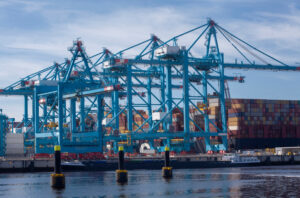The prediction of a three-mega-alliance industry structure has come true, as six of eight carriers left behind from the pending break-up of former alliances have moved fast to join forces, according to the latest Container Insight Report from Drewry Shipping Consultants.
Those left behind, and dubbed ‘orphans’ by Drewry have also moved quickly, as on Friday May 13, 2016 a joint statement from six of the eight carriers – Hanjin Shipping, Hapag-Lloyd, K Line, MOL, NYK and Yang Ming – announced that they would create a new partnership called “THE Alliance” from April 2017.
The statement itself was light on the why’s of the move, the blank space inevitably inviting interested readers to draw their own conclusion that the lines were compelled into this forced marriage.
The statement also clarified that talks between Hapag-Lloyd and UASC are progressing and that the latter is expected to become the seventh member, without saying if that was contingent on a merger taking place or not.
It is also understood that the financially embattled Hyundai Merchant Marine (HMM) will be considered for membership if and when it can sort out its problems.
That means that there could be as many as eight carriers in THE Alliance by the time it comes into being in April, 2017 which does rather look like a case of having too many cooks.
Drewry believes that one solution to help streamline decision making might be to try and install a single independent operational unit, much like the aborted P3 carriers wanted to do before they were knocked back by Chinese regulators.
Therefore, such a move by THE Alliance members could face the same hurdles and be a non-starter if this is the level of integration of operation which they wish.
A lot can still change before next April and there is a chance that the historic coming together of the three Japanese carriers could herald a merger of their liner divisions, while Drewry believe a merger between Hanjin and HMM is a distinct possibility.
Technical Paper: Unprecedented Challenges: Tackling the Biggest Alliances
Certainly, with all three Japanese carriers behind it, THE Alliance is set to have an unrivalled network of services to and from Japan so that the other alliances might possibly regret having not invited one or more of the Nippon carriers into their clubs.
Now that most of the membership questions have been answered and we know that the container shipping market is moving to a three mega-alliance structure, it remains to be seen whether such a streamlining will aid some of the necessary corrective actions on capacity.
In reality, carriers cannot wait nearly a year to start that process if they want to bring supply and demand closer together and see freight rates moving upwards.
The hard work will be in the restructuring of services in 2017 and there will be obvious implications for shippers in terms of who they contract with to protect their supply chains and ensure integrity. During this time there is likely to be continued market volatility.
At the same time, Drewry argues that the transformation into a three-way mega-alliance industry structure is not an oligopoly that shippers should fear as there will still be at least 12 competing carriers and sales organisations behind these operating alliances.
There are also other carriers from within the so-called ‘Top 20’ that are not assigned to an alliance that shippers can call upon, although none are major players in the East-West routes.
Of these carriers the most interesting to watch will be Hamburg Süd (#7 in the Top 20) that currently has around 30,000 TEU of nominal ship capacity in East-West service, giving it a tiny 0.7% share.
Another carrier to keep an eye on will be Zim (#18), which has much more East-West capacity at around 250,000 TEU (giving a share of 3%), which is presently used in looser service partnerships with the G6 Alliance.
Drewry View: The former orphan carriers of the previous split alliances have reacted very fast and effectively to address the risk of becoming isolated in small, uneconomic alliances. They were also wise not to include HMM until its financial stability has been addressed. While some uncertainty has been removed from the market it should be remembered that alliances are only as stable as their member carriers so they should not be seen as the silver bullet that will save the industry.








